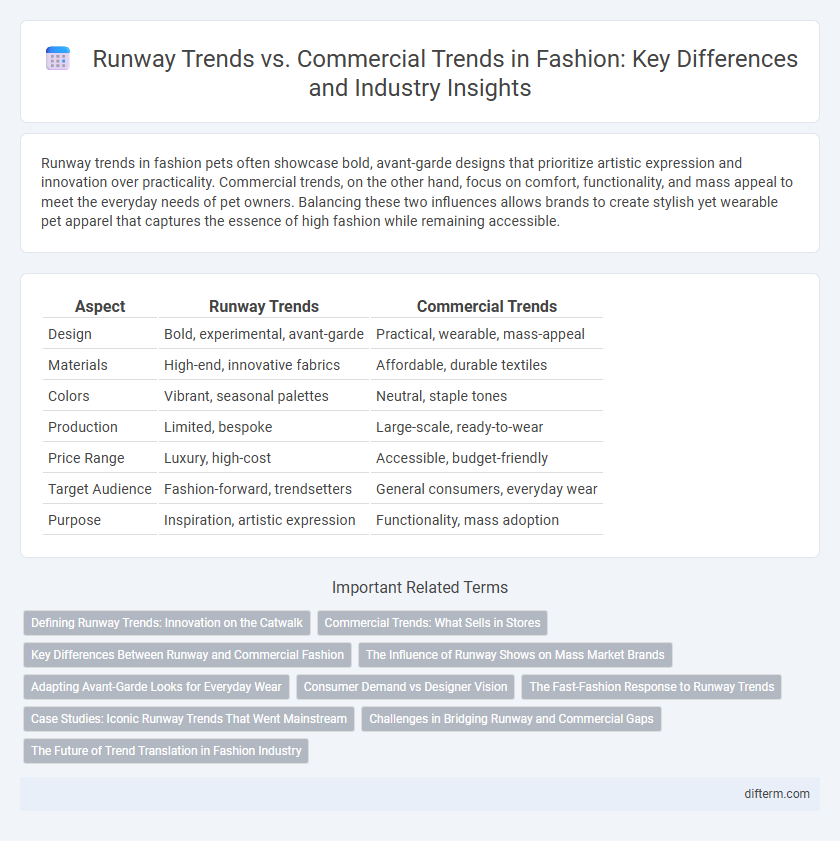Runway trends in fashion pets often showcase bold, avant-garde designs that prioritize artistic expression and innovation over practicality. Commercial trends, on the other hand, focus on comfort, functionality, and mass appeal to meet the everyday needs of pet owners. Balancing these two influences allows brands to create stylish yet wearable pet apparel that captures the essence of high fashion while remaining accessible.
Table of Comparison
| Aspect | Runway Trends | Commercial Trends |
|---|---|---|
| Design | Bold, experimental, avant-garde | Practical, wearable, mass-appeal |
| Materials | High-end, innovative fabrics | Affordable, durable textiles |
| Colors | Vibrant, seasonal palettes | Neutral, staple tones |
| Production | Limited, bespoke | Large-scale, ready-to-wear |
| Price Range | Luxury, high-cost | Accessible, budget-friendly |
| Target Audience | Fashion-forward, trendsetters | General consumers, everyday wear |
| Purpose | Inspiration, artistic expression | Functionality, mass adoption |
Defining Runway Trends: Innovation on the Catwalk
Runway trends exemplify innovation on the catwalk, showcasing avant-garde designs and bold aesthetics from top fashion houses like Chanel, Balenciaga, and Alexander McQueen. These trends prioritize artistic expression and experimental materials, often influencing seasonal colors, silhouettes, and textures featured in luxury fashion weeks such as Paris and Milan. While runway trends push creative boundaries, their commercial adoption depends on market readiness for edgy styles and wearable interpretations from retail brands like Zara and H&M.
Commercial Trends: What Sells in Stores
Commercial trends prioritize wearability and affordability, focusing on pieces that appeal to a broad consumer base and drive consistent sales. Staples like versatile basics, seasonal colors, and adaptable silhouettes dominate retail shelves, reflecting practical demands over avant-garde runway statements. Retailers analyze consumer behavior and sales data to curate collections that blend current fashion with everyday functionality, ensuring profitability and accessibility.
Key Differences Between Runway and Commercial Fashion
Runway fashion showcases avant-garde designs prioritizing artistic expression and innovation, often featuring bold silhouettes and experimental fabrics that set future style directions. Commercial fashion emphasizes wearability and mass appeal, translating runway concepts into accessible, market-ready products that reflect current consumer demand. The key difference lies in runway trends pushing creative boundaries, while commercial trends focus on practicality and widespread retail success.
The Influence of Runway Shows on Mass Market Brands
Runway shows set bold, avant-garde trends that establish the creative direction for each fashion season, influencing designers and stylists worldwide. Mass market brands often adapt these high-concept runway looks into more accessible, wearable styles that resonate with broader consumer bases. This dynamic shapes the retail landscape by translating couture innovation into commercially viable products, driving seasonal collections and consumer demand.
Adapting Avant-Garde Looks for Everyday Wear
Runway trends often showcase avant-garde designs characterized by bold silhouettes, unconventional fabrics, and artistic detailing, setting the tone for future fashion directions. Commercial trends adapt these high-concept looks into wearable, accessible pieces by simplifying shapes, selecting practical materials, and focusing on comfort and functionality. This translation bridges cutting-edge creativity with consumer preferences, driving mass-market appeal and expanding the influence of high fashion in daily wardrobes.
Consumer Demand vs Designer Vision
Runway trends often showcase avant-garde designs driven by a designer's creative vision, emphasizing innovation and artistic expression. Commercial trends, however, reflect consumer demand, prioritizing wearability, affordability, and mass appeal to ensure market success. The fashion industry balances these forces by translating high-concept runway pieces into accessible styles that resonate with everyday shoppers.
The Fast-Fashion Response to Runway Trends
Fast fashion rapidly adapts runway trends into affordable, mass-produced clothing, shortening the traditional fashion cycle from months to weeks. Brands like Zara and H&M excel in translating high-fashion runway styles into commercial-ready pieces, leveraging advanced supply chain management and data analytics. This swift response drives consumer demand by offering trendy, accessible apparel while challenging traditional luxury fashion timelines.
Case Studies: Iconic Runway Trends That Went Mainstream
Iconic runway trends such as Alexander McQueen's dramatic floral prints and Balenciaga's oversized silhouettes exemplify how avant-garde designs transform into commercial staples, influencing retail collections and consumer preferences worldwide. Case studies reveal that Prada's slip dresses and Gucci's maximalist aesthetics transitioned from exclusive fashion shows to mass-market adoption, driving sales and brand visibility. This trajectory highlights the critical role of designers in shaping mainstream fashion through strategic runway innovation and market adaptation.
Challenges in Bridging Runway and Commercial Gaps
Bridging the gap between runway trends and commercial fashion presents challenges in balancing avant-garde designs with consumer wearability and mass production feasibility. Runway collections often prioritize artistic expression and experimentation, which can clash with the practical demands of fit, cost, and seasonality in commercial markets. Retailers and brands must strategically adapt high-concept runway looks into accessible, trend-driven pieces that resonate with mainstream buyers while maintaining brand identity.
The Future of Trend Translation in Fashion Industry
Runway trends often embody avant-garde creativity and conceptual designs that signal the future direction of fashion, while commercial trends prioritize wearability and mass appeal to ensure market success. The future of trend translation in the fashion industry relies on advanced data analytics, AI-driven consumer insights, and real-time social media monitoring to bridge the gap between runway innovation and retail viability. Brands that leverage technology to adapt high-concept runway aesthetics into accessible collections will shape the evolving dynamics of fashion consumption.
runway trends vs commercial trends Infographic

 difterm.com
difterm.com